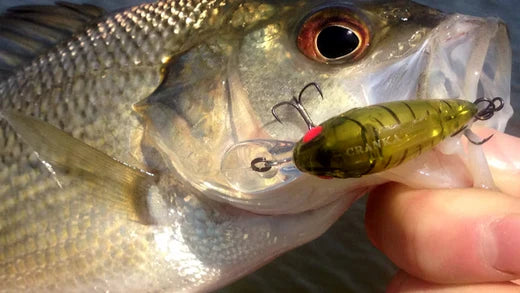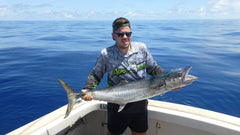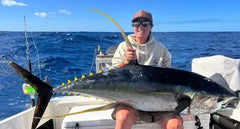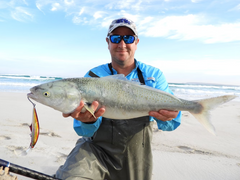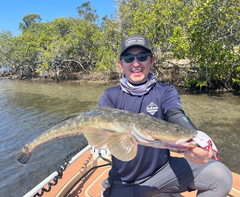Secrets to Catching Australian Bass in Forster, NSW
by Matt HagartyNestled within the Barrington Coast region, Forster, NSW, is a paradise for anglers.
While the lake and estuaries of Forster are well known for some incredible saltwater estuary fishing for Bream, Flathead and Mulloway, not too many people realise that if you venture a bit further upstream, you’ll find some small, picturesque freshwater rivers that hold the mighty Australian Bass. Going from a wider, deeper, more open saltwater estuary system into tighter, shallower river systems with shady tree-covered banks alive with singing cicadas, frogs, lizards and all manner of insects that provide favourite foods for the local Bass population. This guide delves into the world of angling for Australian Bass in this picturesque locale, blending traditional wisdom with specialised insights to elevate your fishing journey in Forster.

What are Australian Bass?
Australian Bass (Macquaria novemaculeata), native to the east coast of Australia, are a testament to the diversity and richness of Australian freshwater ecosystems. Renowned for their robustness and adaptability, they thrive in both fresh and brackish waters. With a lifespan of up to 20 years, these fish are a mainstay in the rivers and estuaries of New South Wales, including Forster, offering both a challenge and reward to anglers.
Characterized by a dark green to olive back, transitioning to a silvery or white underbelly, Australian Bass embody the perfect blend of power and agility. Their streamlined body and broad tail are designed for sudden bursts of speed, making them formidable opponents on the line.
As ambush predators, Australian Bass exhibit a remarkable ability to blend into their surroundings, striking at prey with precision and agility. Their preference for structure and cover is a testament to their survival strategy, avoiding predators while remaining a stealthy predator themselves. By working a snag you know a bass is on over and over, it will eventually flip its lid and just hammer your lure.
Best Conditions to Catch Australian Bass - Day vs Night
Understanding the bass's daily routine is essential. During daylight, they seek shelter, seldom venturing into open shallows to avoid predators, including natural ones like river eagles. Hence, targeting them requires focusing on periods of low light—dawn, dusk, and night time—when they're most active. The further you go upstream, the skinnier the water gets and the more tree coverage there is, allowing you to catch them at almost any hour of the day in shady areas.

Water Temperature, Depth, Barometric Pressure, and Time of Year
Australian Bass favour water temperatures between 14°C to 22°C. Deep pockets in shallow rivers are significant as bass find refuge and cooler temperatures there. Fishing before a storm, when barometric pressure falls, can be productive. Personally, the best time for chasing bass is when the barometer is high and still rising.
The optimal months in Forster stretch from September to April, avoiding the spawning season closure.
Size and Possession Limits for Australian Bass
NSW regulations mandate a minimum size of 30 cm, with varying bag limits throughout the year. Adhering to these ensures the sustainability of this prized species.
What is the Diet of Australian Bass?
Australian Bass have a varied diet including small fish, crustaceans, insects, and even small reptiles and frogs. Anglers can mimic these prey items with an array of lures and baits. Recommended lures include Squidgies 65mm Prawn wriggler for prawns, Shimano Pavlo Shad for bait fish, and Jackson Namazemi for surface action when fish are hitting cicadas.

Technique: Cast tight up against the bank, deep under cover or ahead of a snag, so the lure comes back through the strike zone. With surface lures, let it sit in the zone a bit to attract attention before working it slowly.
Gear for Australian Bass

For gear, use medium-light to medium rods, 2500 to 3000 size reels, and 8-12 lb braided line with a fluorocarbon leader for better invisibility and abrasion resistance.
Matt’s favourite setup includes a Shimano Rack Raider 2-5kg 6’8” rod paired with a Shimano Nasci 2500 reel loaded with Varivas High Grade PE X8 in PE 0.8, with a 10 or 12 lb nylon leader for surface fishing, or fluorocarbon leader for plastics or divers.
Advanced Tactics for Australian Bass
- Targeting Structure: Bass use structures for ambush, so present lures close to these areas. Tree overhangs, submerged rocks, and banks with deep cuts are prime spots.
- Lure Selection and Retrieval Techniques: In shallow waters, use lightweight lures to avoid spooking fish. Spinnerbaits and soft plastics allow for depth control. For shallow diving hardbodies, navigate snags carefully.
- Fishing in Various Conditions: Exploring different habitats, including eddies in fast flows, weed beds, and shaded areas, yields good catches. Night fishing with black surface lures increases chances of hooking larger bass.
Best Spots to Try Your Luck
- Wallamba River
- Coolongolook River
- Wang Wauk River
Closed Season for Australian Bass
The Australian Bass and Estuary Perch closure starts on 1st May, with a zero-bag limit to protect spawning populations until 31st August. This closure is vital for the species’ survival, especially in estuary areas. The rule doesn’t apply in dams where fish do not breed, so winter fishing in dams can be productive.
About the Barrington Coast Region and Forster
The Barrington Coast region, with Forster as its crown jewel, offers a dynamic backdrop for pursuing Australian Bass. This guide, enriched with local knowledge, enhances your angling experience in this beautiful locale. Embrace the strategies outlined here, from understanding bass behavior to choosing the right gear and lures, to elevate your success rates. Enjoy the challenge and sustainable pleasure of bass fishing in Forster, NSW.
For more information on bass fishing in Forster, contact Matt and the team at Barclay's Tackle World Forster.
Contact Information
Barclay's Tackle World Forster
129 Lakes Way Forster NSW 2428
Phone: (02) 6554 5866
See related article on fishing in Forster.



 Select Store
Select Store




